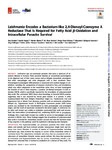Leishmania Encodes a Bacterium-like 2,4-Dienoyl-Coenzyme A Reductase That Is Required for Fatty Acid β-Oxidation and Intracellular Parasite Survival
Semini, Geo
Paape, Daniel
Blume, Martin
Sernee, M. Fleur
Peres-Alonso, Diego
Calvignac-Spencer, Sébastien
Döllinger, Jörg
Jehle, Stefan
Saunders, Eleanor
McConville, Malcolm J.
Aebischer, Toni
Leishmaniaspp. are protozoan parasites that cause a spectrum of im-portant diseases in humans. These parasites develop as extracellular promastigotesin the digestive tract of their insect vectors and as obligate intracellular amastigotesthat infect macrophages and other phagocytic cells in their vertebrate hosts.Promastigote-to-amastigote differentiation is associated with marked changes in me-tabolism, including the upregulation of enzymes involved in fatty acid -oxidation,which may reflect adaptation to the intracellular niche. Here, we have investigatedthe function of one of these enzymes, a putative 2,4-dienoyl-coenzyme A (CoA) re-ductase (DECR), which is specifically required for the -oxidation of polyunsaturatedfatty acids. TheLeishmaniaDECR shows close homology to bacterial DECR proteins,suggesting that it was acquired by lateral gene transfer. It is present in othertrypanosomatids that have obligate intracellular stages (i.e.,Trypanosoma cruziandAngomonas) but is absent from dixenous parasites with an exclusively extracellularlifestyle (i.e.,Trypanosoma brucei). A DECR-green fluorescent protein (GFP) fusionprotein was localized to the mitochondrion in both promastigote and amastigotestages, and the levels of expression increased in the latter stages. ALeishmania ma-jorΔdecrnull mutant was unable to catabolize unsaturated fatty acids and accumu-lated the intermediate 2,4-decadienoyl-CoA, confirming DECR’s role in -oxidation.Strikingly, theL. majorΔdecrmutant was unable to survive in macrophages and wasavirulent in BALB/c mice. These findings suggest that -oxidation of polyunsaturatedfatty acids is essential for intracellular parasite survival and that the bacterial originof key enzymes in this pathway could be exploited in developing new therapies.
Dateien zu dieser Publikation

